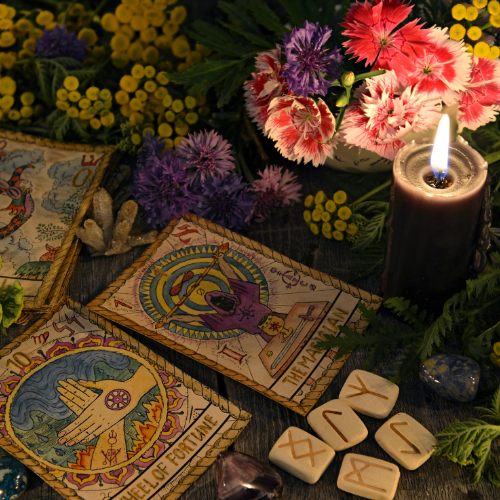The Tarot is a captivating world of symbolism and insight, often associated with mysticism and divination. While it can seem intimidating at first, learning how to use Tarot cards is an exciting journey that can help you gain clarity, self-awareness, and guidance in various aspects of your life. In this beginner's guide, we'll walk you through the basics of Tarot card reading and provide you with the tools to start your exploration.
The first step in using Tarot cards is to select a deck that resonates with you. There are countless Tarot decks available, each with its unique artwork and symbolism. Popular choices include the Rider-Waite Tarot, the Crowley-Harris Thoth Tarot, and the Wild Unknown Tarot. Take your time to explore different decks, and choose one that speaks to your intuition and personal preferences.
2. Getting Familiar with the Cards:
A typical Tarot deck consists of 78 cards, divided into two main groups: the Major Arcana (22 cards) and the Minor Arcana (56 cards). Each card has its symbolism and meaning. To begin using Tarot cards, start by studying and familiarizing yourself with the meanings of each card. Many Tarot books, online resources, and apps provide detailed explanations of card meanings.
Before diving into a Tarot reading, it's essential to create a calm and focused environment. Find a quiet space where you won't be disturbed and set the mood with soft lighting, calming music, or incense. Some readers like to meditate or ground themselves before starting a reading to enhance their intuitive abilities.
Tarot readings are often centered around specific questions or concerns. It's crucial to frame your questions in a clear and open-ended manner. Instead of asking, "Will I get the job?" try something like, "What do I need to know about my career prospects?"
5. Shuffling and Drawing Cards:
Hold your Tarot deck in your hands and shuffle the cards while focusing on your question. Some readers prefer to shuffle extensively, while others do a simple shuffle. When you feel ready, draw the cards one by one and place them in a spread.
6. Understanding Card Spreads:
There are numerous Tarot spreads to choose from, depending on your question and preference. The most common is the three-card spread, which represents past, present, and future aspects of a situation. More complex spreads like the Celtic Cross offer deeper insights but may require more experience.
While the Tarot cards have established meanings, your intuition plays a significant role in interpreting them. Pay attention to your initial impressions, emotions, and the images on the cards. These can offer unique insights tailored to your situation.
Consult your Tarot resources or your knowledge of card meanings to interpret the cards in your spread. Keep in mind that Tarot readings are not set in stone; they offer guidance and possibilities rather than fixed predictions.
After your reading, take time to reflect on the messages and insights you've gained. Consider how they relate to your life and the questions you asked. With practice, you'll become more attuned to the Tarot's language and symbolism.
10. Practice, Patience, and Respect:
Learning how to use Tarot cards is a journey that requires practice and patience. Be respectful of the Tarot's power and symbolism, and remember that it can provide profound guidance when used with sincerity and intention.
In conclusion, Tarot cards are a powerful tool for self-discovery and insight. Whether you're seeking guidance, clarity, or a deeper understanding of your life's path, the Tarot can be a valuable companion on your journey. As you explore the world of Tarot, keep an open heart and an open mind, and trust in the wisdom that these mystical cards can offer.
